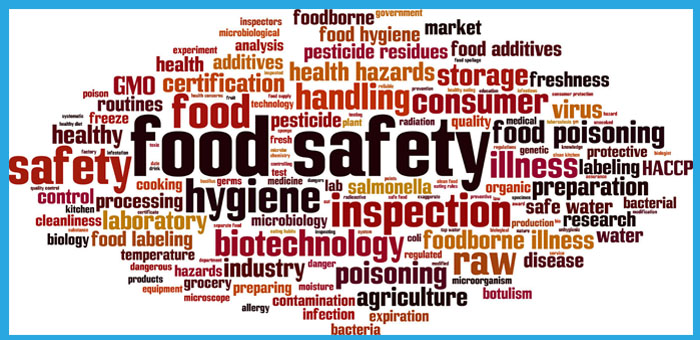Food truck operators understand the challenge of keeping a culture of cleanliness in their truck. Good routines and habits can be difficult to reinforce, but it’s important as errors in kitchen sanitation can lead to contaminated food and poor, or even failed health inspections. To help keep your food truck clean and avoid a situation that could lead to a foodborne outbreak, be sure to make cleanliness a top priority. Today we’ll look at the top five food safety mistakes you don’t want your food truck staff making.
5 Common Food Safety Mistakes To Avoid
Handling foods safely is much more than throwing away expired milk or washing your fruits and vegetables. While these actions are important, there are several more common food safety mistakes that can result in major consequences.
Improper Food Temperatures
The first of our food safety mistakes is the most common. Temperature control is tricky because, as you know, different foods require different storage temperatures. Monitoring proper food temperature should be a constant process in your food truck or commercial kitchen, from the time it is delivered to the time it arrives in your customer’s hands. Foods left out for an extended period of time are susceptible to pest contamination, and unmonitored temperature control is one of the most common causes of a foodborne illnesses.
- Keep hot food hot: at or above 140°F.
- Keep cold food cold: at or below 40°F. Place food in containers on ice.
- Foods should be reheated thoroughly to an internal temperature of 165°F or until hot and steaming.
RELATED: Monitoring Proper Food Temperature In Your Food Truck
Incorrect Food Labeling
It’s important that when you cook food and store it, you label it properly with a date. Labels should include the time the food was made because that determines when it should be thrown out. Train your food truck staff to correctly label food by using the following best practices from the FDA.
- Label food with “best if used by” date recommendation for best food flavor or quality.
- Include the “use-by” date set by the manufacturer as the last date recommended for the use of the product.
- Practice “first in, first out” (FIFO) as a general rule.
RELATED: Selecting An Inventory Accounting System For Your Truck
Staff Eating On The Job
Pests are constantly looking for food and water, so any crumb left on the floor or countertop will be enough to attract them inside your truck. Do your employees know that eating in food prep areas is a health code violation? Never assume your employees are well-versed in the do’s and don’ts of the kitchen. Take some time to ensure they feel comfortable asking for clarity if they:
- Are unfamiliar with your food truck’s food handling procedures.
- Feel they do not have the resources or time to commit to proper food safety protocols.
- Need a refresher on ways to help prevent foodborne illness in the kitchen.
RELATED: What Food Vendors Need To Know About The Food Handler Certificate
Poor Hand Washing
It doesn’t take long to properly wash hands, but the fast-paced food truck environment tempts food workers to continually cut corners to make up time. But the harsh reality is those who don’t thoroughly wash their hands can transmit foodborne illnesses. The following outlines the simple routine recommended by the CDC:
- Wet your hands with clean, running water (warm or cold), turn off the tap, and apply soap.
- Lather your hands by rubbing them together with the soap. Be sure to lather the backs of your hands, between your fingers, and under your nails.
- Scrub your hands for at least 20 seconds. Need a 20-second timer? Hum the “Happy Birthday” song from beginning to end twice.
- Rinse your hands well under clean, running water. Dry your hands using a clean towel or air-dry them.
RELATED: Recognizing National Hand Washing Week in Your Food Truck
Incorrect Food Storage
To close out our list of top food safety mistakes we center on food storage. There isn’t an easier way to contaminate your food supplies than to store it incorrectly. To ensure your employees are taking the appropriate steps to minimize the threat of foodborne illness by contamination, share these tips.
- Ensure that your food vendors use a pest management program.
- Inspect arriving shipments for signs of pest activity before accepting. If any evidence is found, refuse the shipment and contact your supplier.
- Keep food away from dishwashing areas, cleaning supplies, and garbage containers.
- Even in a sealed container, meat or meat dishes should be stored below other items so the juices cannot drip and contaminate those items.
- Wrap food with tight-fitting plastic wrap or aluminum foil before storing it when it’s not being used.
RELATED: The Importance Of Having An Organized Kitchen For Your Food Truck
Other Food Safety Mistakes
- Food truck lacks HACCP documentation.
- No paper towels (of single use) in truck.
- Hand washing station was full of smallwares.
- Cross-contamination.
- Improper currency handling.
There are many more food safety mistakes but these were some of the most common.
The Bottom Line
Running a food truck is lucrative for those who succeed, but any vendor will tell you it takes a lot more than perfect parking locations, excellent service and mouthwatering dishes to do so. Don’t let one of your customers be one of the 48 million Americans sickened by food poisoning each year. Avoid these common yet dangerous food safety mistakes.
Teaching your food truck staff the tips in this article will help keep your customers safe and help your food truck pass upcoming health inspections.
Do you have any additional food safety tips for food truck owners? Share your thoughts on this topic in the comment section, our food truck forum or social media. Facebook | Twitter




